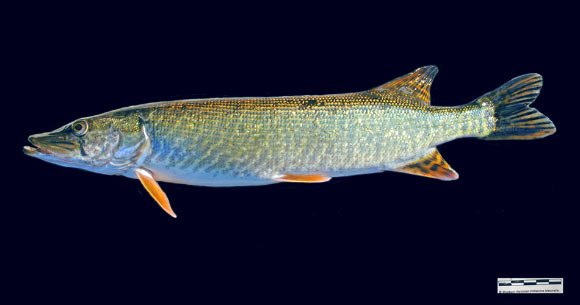French ichthyologists led by Dr Philippe Keith of the National Museum of Natural History in Paris have described a new species of pike from the Charente to the Adour drainages of France.
In France, pike is considered by default to be Esox lucius, a species commonly known as the Northern pike.
The fish is native to the Rhine, Seine, Loire, and Rhône drainages. There are records of its introduction in the small coastal French Mediterranean rivers out of the Rhône itself.
Archeological data indicate the presence of the Northern pike in the region called Aquitaine during the Pleistocene (2.5 million to 11,700 years ago), suggesting that it is native to the Dordogne and Garonne rivers and maybe also in the Adour drainage.
To clarify the taxonomy of pikes present in France, Dr Keith and his colleagues from the University of Claude-Bernard in Lyon and the National Museum of Natural History in Paris analyzed morphological and molecular data on 19th century and recent specimens collected in the main French drainages.
Surprisingly, the data revealed the presence of three distinct species: the expected and widely distributed Northern pike (Esox lucius), the Cisalpine pike (Esox cisalpinus, in the 19th century in Lake Geneva) and a previously unknown species.
The new species has been named the Aquitanian pike (Esox aquitanicus) as it was found in Aquitaine.
“The fish has grey to yellow-green flanks adorned with 16 to 30 oblique vertical bars with a width of 1–1.5 scale (very well marked in juveniles), which tend to be discontinuous into little irregular white blotches in larger fish, conferring a marbled aspect with very small white blotches,” Dr Keith and his co-authors wrote in a paper published in the journal Comptes Rendus Biologies.
“The fins’ color is yellow to orange. Dark pigmentation on paired fins are faint, as opposed to the unpaired fins which have well-developed dark vermiculations.”
Like the Northern and the Cisalpine pike, young individuals of the Aquitanian pike have a contrasting brownish vertical bar under the eye.
According to Dr Keith’s team, the new fish can exceed 1 meter in total length.
“A pike of 1.37 meters was mentioned by a French scientist in 1853 in Lake Cazeau, right in the heart of the distribution area of the Aquitanian pike.”
The fish is present in the Charente, Dordogne, Eyre, and Adour basins. Lake Mouriscot constitutes its currently known most southern location.
“The Aquitanian pike should have similar ecological characteristics as the Northern pike in terms of habitat, behavior, and predation, because no difference were mentioned about ecological traits between Aquitanian and the other French pike populations, except an earlier spawning in February instead of March-April.”
When there is cohabitation between the two species, the Aquitanian pike is able to hybridize with the Northern pike.
“It is possible that Aquitanian pike is stocked and sold as the Northern pike by fish farmers of southwestern France, in order to restock waterbodies in France or abroad for sport fishing,” the scientists said.
“Studies are strongly required to better assess the actual status and distribution of this new species.”
_____
G.P.J. Denys et al. Morphological and molecular evidence of three species of pikes Esox spp. (Actinopterygii, Esocidae) in France, including the description of a new species. Comptes Rendus Biologies, published online August 05, 2014; doi: 10.1016/j.crvi.2014.07.002








